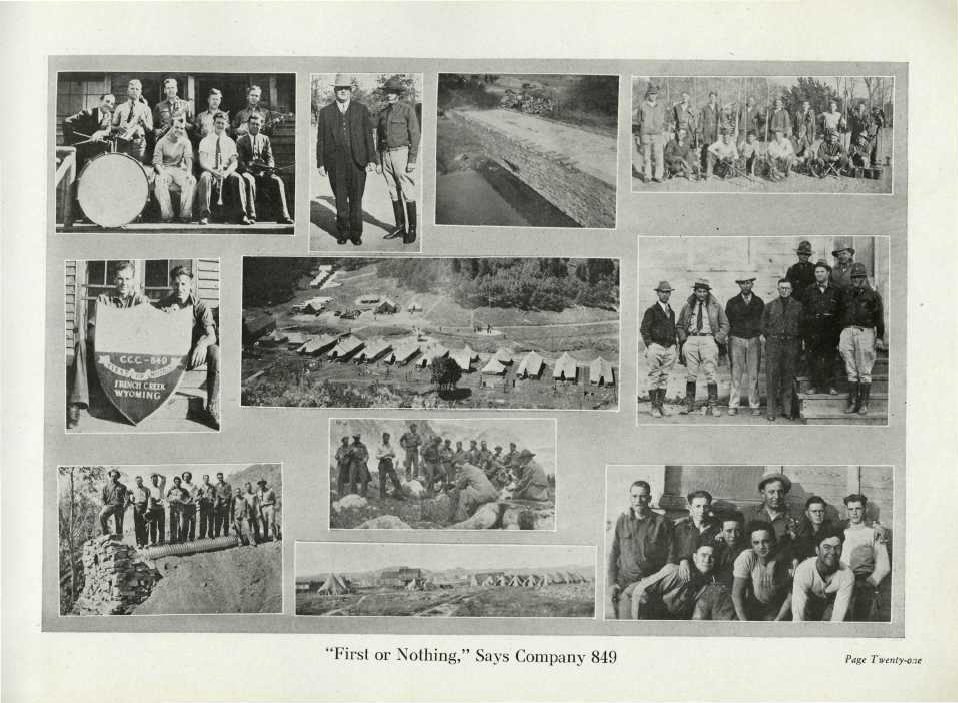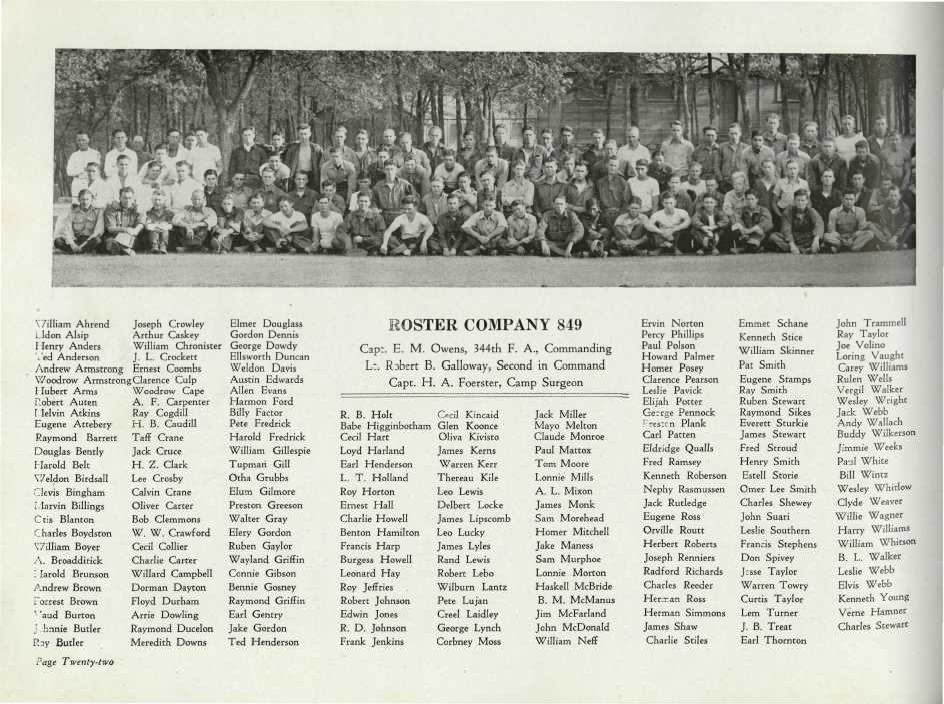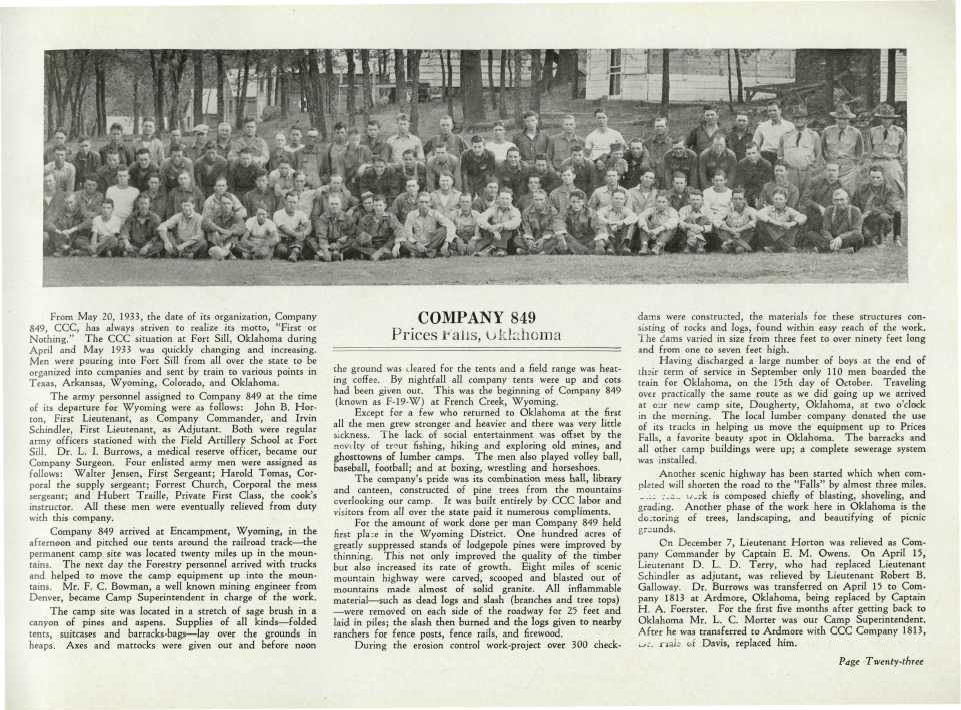Prices Falls, Oklahoma
Copied from Oklahoma District Civilian Conservation Corps Pictorial Review, page 23:
From May 20, 1933, the date of its organization, Company 849, CCC, has always striven to realize its motto, “First or Nothing.” The CCC situtation at Fort Sill, Oklahoma during April and May 1933 was quickly changing and increasing. Men were pouring into Fort Sill form all over the state to be organized into companies and sent by train to various points in Texas, Arkansas, Wyoming, Colorado, and Oklahoma.
The army personal assigned to Company 849 at the time of its departure for Wyoming were as follows: John B. Horton, First Lieutenant, as Company Commander, and Irvin Schindler, First Lieutenant, as Adjutant. Both were regular army officers stationed at the Field Artillery School at Fort Sill. Dr. L. L. Burrows, a medical reserver officer, became the Company Surgeon. Four enlisted army men were assigned as follows: Walter Jensen, First Sergeant; Harold Tomas, Corporal the supply sergeant; Forrest Church, Corporal the mess sergeant; and Hubert Traille, Private First Class, the cook’s instructor. All these men were eventually relieved from duty with this company.
Company 849 arrived at Encampment, Wyoming in the afternoon and pitched our tents around the railroad track-the permanent camp site was located twenty miles up in the mountains. The next day the Forestry personnel arrived with trucks and helped to move the camp equipment up into the mountains. Mr. F.C. Bowman, a well known mining engineer from Denver, became Camp Superintendent in charge of the work.
The camp site was located in a stretch of sage brush in a canyon of pines and aspens. Supplies of all kinds-folded tents, suitcases and barracks-bags-lay over the grounds in heaps. Axes and mattocks were given out and before noon the ground was cleared for the tents and a field range was heating coffee. By nightfall all company tents were up and cots had been given out. This was the beginning of Company 849 (known as F-19-W) at French Creek, Wyoming.
Except for a few who returned to Oklahoma at the first all the men grew stronger and heavier and there was very little sickness. The lack of social entertainment was offset by the novelty of trout fishing, hiking, and exploring old mines, and ghoststowns of lumber camps. The men also played volley ball, baseball, football; and at boxing, wrestling and horseshoes.
The company’s pride was its combination mess hall, library, and canteen, constructed of pine trees from the mountains overlooking our camp. It was built entirely by CCC labor and visitors from all over the state paid it numerous compliments.
For the amount of work done per man Company 849 held first place in the Wyoming District. One hundred acres of greatly suppressed stands of lodgepole pines were improved by thinning. This not only improved the quality of the timber but also increased the rate of growth. Eight miles of scenic mountain highway were carved, scooped and blasted out of mountains made almost of solid granite. All inflammable material-such as dead logs and slash (branches and tree tops) – were removed on each side of the roadway for 25 feet and laid in piles; the slash then burned and logs given to nearby ranchers for fence posts, fence rails, and firewood.
During the erosion control work-project over 300 check-dams were constructed, the materials for theses structures consisting of rocks and logs, found within easy reach of the work. The dams varied in size from three feet to over ninety feet long and from one to sever feet high.
Having discharged a large number of boys at the end of thier term of service only 110 men boarded the train for Oklahoma, on the 15th day of October. Traveling over practically the same route as we did going up we arrived at our new camp site, Dougherty, Oklahoma, at two o’clock in the morning. The local lumber company donated the use of its trucks in helping up move the equipment up to Prices Falls, a favorite beauty spot in Oklahoma. The barracks and all other camp buildings were up; a complete sewerage system was installed.
Another scenic highway has been stated which when completed will shorten the road to the “Falls” by almost three miles. Most of the work is composed chiefly of blasting, shoveling, and grading. Another phase of the work here in Oklahoma is the doctoring of trees, landscaping, and beatifying of picnic grounds.
On December 7, Lieutenant Horton was relieved as Company Commander by Captain E. M. Owens. On April 15, Lieutenant D.L.D. Terry, who had replaced Lieutenant Schindler as adjutant, was relieved by Lieutenant Robert B. Galloway. Dr. Burrows was transferred on April 15 to Company 1813 at Ardmore, Oklahoma, being replaced by Captian H.A. Foerster. For the first five months after getting back to Oklahoma Mr. L.C. Morter was our Camp Superintendent. After he was transferred to Ardmore with CCC Company 1813, ?? of Davis, replaced him.



Sources
- Oklahoma District Civilian Conservation Corps Pictorial Review, 1938



Recent Comments